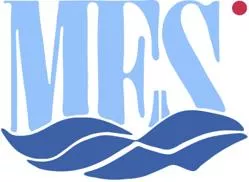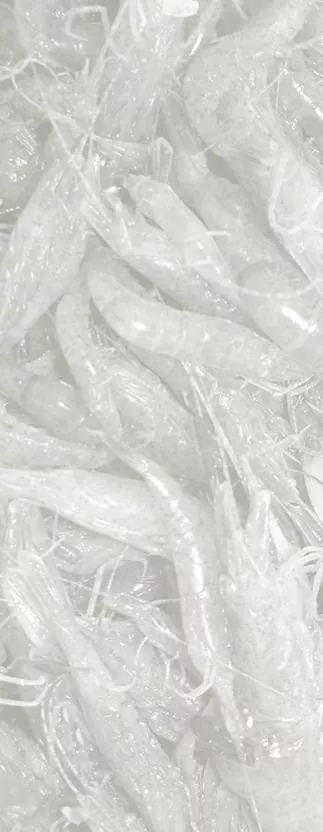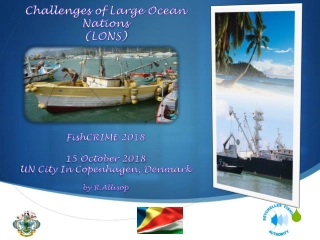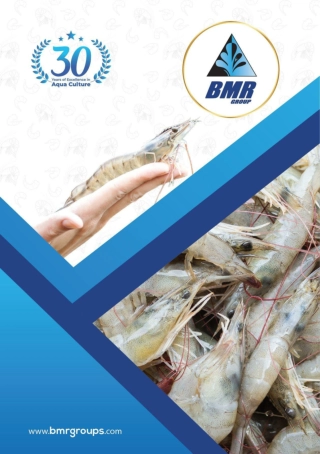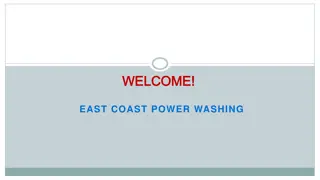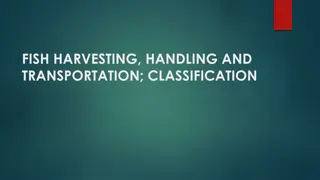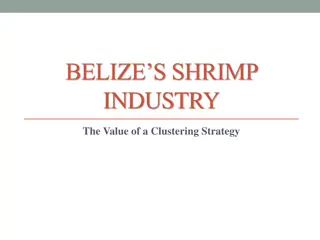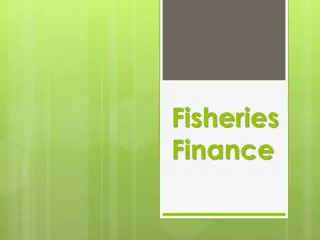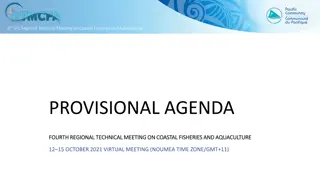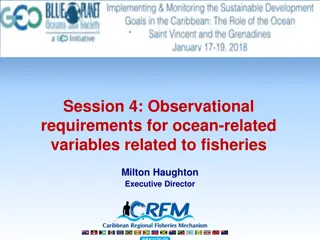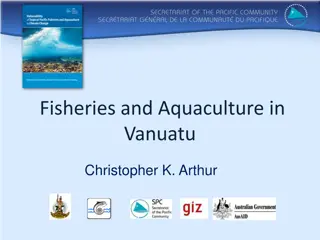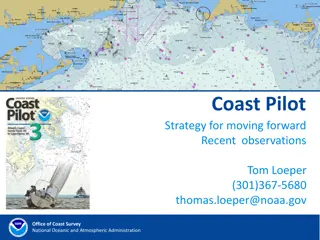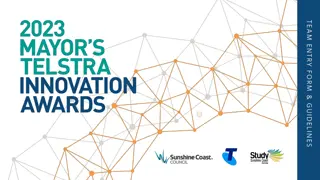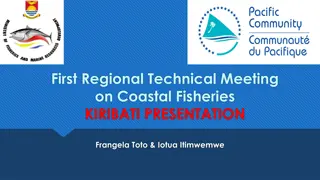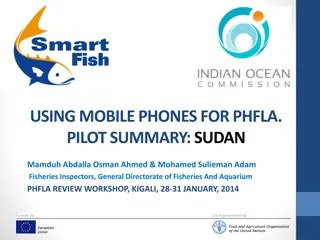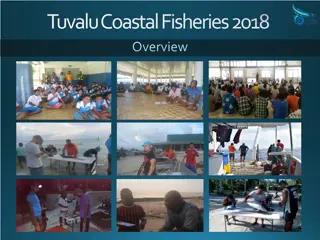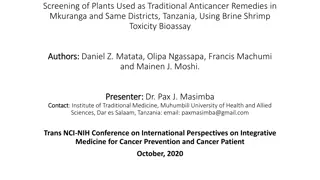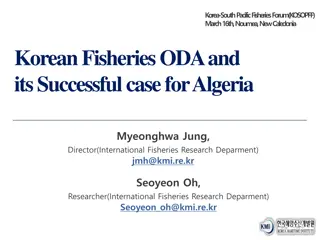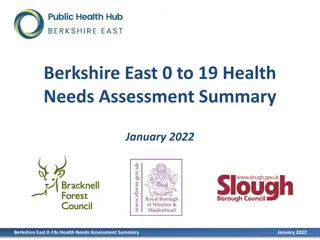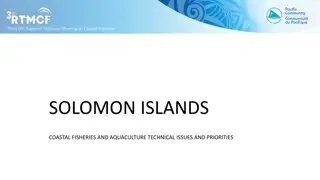Preliminary Assessment of East Coast Shrimp Fisheries
Provisional pre-assessment report by Marine Ecological Surveys Limited on East Coast Brown and Pink Shrimp Fisheries. Identifies areas for sustainable improvements in line with MSC criteria. Covers stock health, ecosystem impact, and management strategies.
Download Presentation

Please find below an Image/Link to download the presentation.
The content on the website is provided AS IS for your information and personal use only. It may not be sold, licensed, or shared on other websites without obtaining consent from the author. Download presentation by click this link. If you encounter any issues during the download, it is possible that the publisher has removed the file from their server.
E N D
Presentation Transcript
Pre-Assessment of the East Coast Brown and Pink Shrimp Fisheries Marine Ecological Surveys Limited 3 Palace Yard Mews Bath, BA1 2NH Tel: +44 (0) 1225 442211 Email: marine@seasurvey.co.uk www.seasurvey.co.uk Matt Green, Jackie Hill, Bryony Pearce, Tania Woodcock, Sheryl Earnshaw & Kirsty Ball. 2011.
Pre-Assessment of the East Coast Brown and Pink Shrimp Fisheries Marine Ecological Surveys Limited 3 Palace Yard Mews Bath, BA1 2NH Tel: +44 (0) 1225 442211 Email: marine@seasurvey.co.uk www.seasurvey.co.uk Matt Green, Jackie Hill, Bryony Pearce, Tania Woodcock, Sheryl Earnshaw & Kirsty Ball. 2011.
Contents Purpose of a pre-assessment Brief recap of MSC principles Brown shrimp fishery Scores Key recommendations Stock Non-target species Habitats and Ecosystems Management Pink shrimp fishery Scores Key recommendations Marine Ecological Surveys Limited 3 Palace Yard Mews Bath, BA1 2NH Tel: +44 (0) 1225 442211 Email: marine@seasurvey.co.uk www.seasurvey.co.uk
Purpose of a Pre-assessment A provisional assessment prior to full MSC sustainability assessment and ecolabelling Based on client and background information To provide GUIDANCE to improved sustainability to meet MSC criteria To inform the management plan Marine Ecological Surveys Limited 3 Palace Yard Mews Bath, BA1 2NH Tel: +44 (0) 1225 442211 Email: marine@seasurvey.co.uk www.seasurvey.co.uk
Marine Stewardship Council (MSC) Standard Principle Criteria Number of PIs P.1. Health of Fish Stock Outcome (stock status) Harvest Strategy (Management) 3 4 P.2. Impact on Ecosystem Retained Species By-catch Species ETP Species Habitats Ecosystem 3 3 3 3 3 P.3. Management System Governance & Policy Fishery Specific Management System 4 5 Aiming for GOOD PRACTICE The MSC scoring system (Clark, 2008) Marine Ecological Surveys Limited 3 Palace Yard Mews Bath, BA1 2NH Tel: +44 (0) 1225 442211 Email: marine@seasurvey.co.uk www.seasurvey.co.uk A score of 80
Brown shrimp pre-assessment scores Standards for MSC certification not met in 17 criteria Improvements required in 7 criteria Principle One The Stock Outcome 1.1.1 1.1.2 60-80 <60 Harvest Strategy 1.2.1 1.2.2 <60 <60 1.1.3 N/A 1.2.3 <60 1.2.4 <60 Principle Two Impact on the Environment Retained Species 2.1.1 2.1.2 2.1.3 <60 <60 <60 By-catch Species 2.2.1 2.2.2 <60 <60 ETP Species 2.3.1 60-80 Habitats Ecosystem 2.5.1 <60 2.2.3 <60 2.3.2 80 2.3.3 2.4.1 80 2.4.2 60-80 2.4.3 60-80 2.5.2 <60 2.5.3 60-80 60-80 Marine Ecological Surveys Limited 3 Palace Yard Mews Bath, BA1 2NH Tel: +44 (0) 1225 442211 Email: marine@seasurvey.co.uk www.seasurvey.co.uk Principle Three Fishery Management Governance and Policy 3.1.1 3.1.2 3.1.3 60-80 80 <60 80 60-80 <60 Pass Conditional pass Fail Fishery Specific Management System 3.1.4 3.2.1 3.2.2 <60 <60 80 3.2.3 80 3.2.4 <60 3.2.5 80
Brown shrimp pre-assessment scores It s not all bad! Some measures already in place formalise them Improvements to data capture Documentation management plan Principle One The Stock Outcome 1.1.1 1.1.2 60-80 <60 Harvest Strategy 1.2.1 1.2.2 <60 <60 1.1.3 N/A 1.2.3 <60 1.2.4 <60 Principle Two Impact on the Environment Retained Species 2.1.1 2.1.2 2.1.3 <60 <60 <60 By-catch Species 2.2.1 2.2.2 <60 <60 ETP Species 2.3.1 60-80 Habitats Ecosystem 2.5.1 <60 2.2.3 <60 2.3.2 80 2.3.3 2.4.1 80 2.4.2 60-80 2.4.3 60-80 2.5.2 <60 2.5.3 60-80 60-80 Marine Ecological Surveys Limited 3 Palace Yard Mews Bath, BA1 2NH Tel: +44 (0) 1225 442211 Email: marine@seasurvey.co.uk www.seasurvey.co.uk Principle Three Fishery Management Governance and Policy 3.1.1 3.1.2 3.1.3 60-80 80 <60 80 60-80 <60 Pass Conditional pass Fail Fishery Specific Management System 3.1.4 3.2.1 3.2.2 <60 <60 80 3.2.3 80 3.2.4 <60 3.2.5 80
Key Recommendations for the Brown Shrimp Fishery 1. Stock 2. Non-target species Undertake stock assessment and harvest strategy Improve fishing selectivity Develop a harvest strategy Monitor ICES status of by-catch species Establish a Fishery Management Group Collect biomass data for by-catch Seek expert advice Reduce juvenile fish by-catch Improve LPUE data Improve survivability of by-catch Minimise undersized shrimp mortality Monitor and record ETP species Implement a management plan Implement a management plan 1. Habitat and Ecosystem 4. Management Identify and map habitats in fishing area Develop and document management plan Improve fishing effort data collection Establish Fishery Management Group Marine Ecological Surveys Limited 3 Palace Yard Mews Bath, BA1 2NH Tel: +44 (0) 1225 442211 Email: marine@seasurvey.co.uk www.seasurvey.co.uk Implement management measures
Key Recommendations for the Brown Shrimp Fishery 1. Stock 2. Non-target species Undertake stock assessment and set a harvest strategy Improve fishing selectivity Develop a harvest strategy Monitor ICES status of by-catch species Establish a Fishery Management Group Collect biomass data for by-catch Seek expert advice Reduce juvenile fish by-catch Improve LPUE data Improve survivability of by-catch Minimise undersized shrimp mortality Monitor and record ETP species Implement a management plan Implement a management plan 1. Habitat and Ecosystem 4. Management Identify and map habitats in fishing area Develop and document management plan Improve fishing effort data collection Establish Fishery Management Group Marine Ecological Surveys Limited 3 Palace Yard Mews Bath, BA1 2NH Tel: +44 (0) 1225 442211 Email: marine@seasurvey.co.uk www.seasurvey.co.uk Implement management measures
R1: Monitoring and Management of Stock 1.1 Undertake stock assessment Assessing stock status in shrimp is known to be problematic for several reasons: shrimp abundance in one year does not give information about stock in the following year probably because >1 generation per year Short life-span high variability in local catches The ICES WG have discussed 3 other potential approaches to stock assessment Surveys using standardised catches from commercial vessels Ad hoc regulation - set reference points based on LPUE data and implement a traffic light system of management measures (currently employed in the Dutch North Sea shrimp fishery) Use indicators of stock status such as a combination of size distribution, maximum length, number of berried females Marine Ecological Surveys Limited 3 Palace Yard Mews Bath, BA1 2NH Tel: +44 (0) 1225 442211 Email: marine@seasurvey.co.uk www.seasurvey.co.uk
R1: Monitoring and Management of Stock Ad hoc shrimp fishery regulation Based on already established EU reporting system of log-books and landings data A sub-set of shrimpers provide catch and effort data Averages are calculated and distributed within a short time frame Reference points (minimum monthly LPUE) can be established using expert judgement (a rule of thumb e.g. 75% of average) and previous LPUE data Implement a traffic light system of actions e.g.: LPUE is high => free fishing LPUE is moderate => fishing on higher effort limited Marine Ecological Surveys Limited 3 Palace Yard Mews Bath, BA1 2NH Tel: +44 (0) 1225 442211 Email: marine@seasurvey.co.uk www.seasurvey.co.uk LPUE is low => danger for stocks => fishing restrictions
R1: Monitoring and Management of Stock Surveys using standardised catches from commercial vessels simultaneous standardised catches on as many commercial vessels as possible first survey in May/June to catch recruitment wave (10-20 mm), may need special licence for smaller mesh sizes second survey in summer, July/August, this recruitment cohort will now be 30-45 mm in size trawl information collected for each haul (duration, location) employ sieving procedures to identify biomass of different cohorts sub-sampling by scientists for more detailed investigation of stock structure also collect information on egg-bearing females simultaneous recording of by-catch to identify areas with high by-catch for first year it may be necessary to undertake more regular sampling Marine Ecological Surveys Limited 3 Palace Yard Mews Bath, BA1 2NH Tel: +44 (0) 1225 442211 Email: marine@seasurvey.co.uk www.seasurvey.co.uk
R1: Monitoring and Management of Stock A combination of indicators of stock status no. of egg bearing females size composition maximum length size distribution of area predator biomass environmental conditions Gives real insight into the drivers of population but Must be carried out by scientists and lack of clarity on how to interpret data or base management actions on these parameters Marine Ecological Surveys Limited 3 Palace Yard Mews Bath, BA1 2NH Tel: +44 (0) 1225 442211 Email: marine@seasurvey.co.uk www.seasurvey.co.uk Need to discuss and seek advice on best way forward
R1: Monitoring and Management of Stock 1.2 Develop harvest strategy set reference points on basis of survey data or other set reference points based on LPUE data implement traffic light system of management measures as in Dutch fishery 1.3 Establish fishery management group the producers IFCA representatives Cefas representative (link FMG and WG?) with advice from ICES Working Group 1.4 Seek expert advice ICES Shrimp working group Dutch shrimp fishery experiences (Management plan in information pack) Cefas has participated in the ICES Crangon working group (Andy Lawler) Marine Ecological Surveys Limited 3 Palace Yard Mews Bath, BA1 2NH Tel: +44 (0) 1225 442211 Email: marine@seasurvey.co.uk www.seasurvey.co.uk
R1: Monitoring and Management of Stock Dutch shrimp fishery management measures Feb 2011 Weekend prohibition and fishing times The indicator for the stock status is Landings Per Unit Effort (LPUE) in kg/hr Every 4 weeks the average LPUE is calculated from a selected sample of fishing vessels Traffic light system of measures depending on average LPUE. For example if LPUE falls below X fishing is limited to a maximum number of hours per week Separate traffic light levels weeks 1-24 and weeks 25-52 to allow for seasonal differences in catch Maximum percentage of 15% for shrimp residue for each landing Minimum net mesh size Use of sieve nets Development of alternative fishing methods Recognised rinsing/sorting equipment and recognised handling methods (all documented) By-catch monitoring Endangered species monitoring Closed areas for shrimp fishing Maximum vessel capacity Use of prescribed fishing gear only Marine Ecological Surveys Limited 3 Palace Yard Mews Bath, BA1 2NH Tel: +44 (0) 1225 442211 Email: marine@seasurvey.co.uk www.seasurvey.co.uk
R1: Monitoring and Management of Stock 1.5 Improve landings per unit effort data hours actually fished not days at sea North Sea fishery advised by ICES to address LPUE data collection (different systems, landings only, data collected) 1.7 Minimise undersized shrimp mortality formalise mesh size of cod end with signed agreements investigate other methods such as processing and handling in Dutch fishery 1.8 Implement a management plan formal document of stock and harvest strategy measures systems of recording, reporting and feedback traffic light management measures, seasonal closures etc Marine Ecological Surveys Limited 3 Palace Yard Mews Bath, BA1 2NH Tel: +44 (0) 1225 442211 Email: marine@seasurvey.co.uk www.seasurvey.co.uk
Key Recommendations for the Brown Shrimp Fishery 1. Stock 2. Non-target species Undertake stock assessment and set a harvest strategy Improve fishing selectivity Develop a harvest strategy Monitor ICES status of by-catch species Establish a Fishery Management Group Collect biomass data for by-catch Seek expert advice Reduce juvenile fish by-catch Improve LPUE data Improve survivability of by-catch Minimise undersized shrimp mortality Monitor and record ETP species Implement a management plan Implement a management plan 3 . Habitat and Ecosystem 4. Management Identify and map habitats in fishing area Develop and document management plan Improve fishing effort data collection Establish Fishery Management Group Marine Ecological Surveys Limited 3 Palace Yard Mews Bath, BA1 2NH Tel: +44 (0) 1225 442211 Email: marine@seasurvey.co.uk www.seasurvey.co.uk Implement management measures
R2: Monitoring and Management of Non-Target Species 2.1 Improve Fishing Selectivity formalise the mandatory use of sieve nets in management plan obtain signed agreements monitor developments in other fisheries Electric beam trawling for Crangon ILVO 35% less by-catch 75% less bottom contact Marine Ecological Surveys Limited 3 Palace Yard Mews Bath, BA1 2NH Tel: +44 (0) 1225 442211 Email: marine@seasurvey.co.uk www.seasurvey.co.uk
R2: Monitoring and Management of Non-Target Species 2.2 Collect biomass data for by-catch necessary to determine which by-catch species count as main ( 5%) consider seasonal and/or spatial surveys + independent observation 2.3 Monitor ICES status of non-target species regular checks to determine changes in definitions for vulnerable ( main ) species, currently only cod is considered vulnerable but several unknown formalise process in management plan responsibility of the fishery management group Marine Ecological Surveys Limited 3 Palace Yard Mews Bath, BA1 2NH Tel: +44 (0) 1225 442211 Email: marine@seasurvey.co.uk www.seasurvey.co.uk
R2: Monitoring and Management of Non-Target Species 2.4 Reduce juvenile fish by-catch collect information on where and when juvenile (plaice in particular) catch is high There may be funding available, e.g. EFF, to carry out surveys implement technical measures (seasonal/area closures, gear/handling procedures) 2.5 Investigate and improve survivability of discards No research carried out as far as we could tell But automated catch handling equipment used in some modern vessels may improve survivability by reducing catch handling time introduction of agreed a handling methods known to improve the chance of survivability, as has been used in Holland such as using high levels of running water to return by-catch to the water and releasing fish directly into the water via a chute underneath or at the side of the boat Research required Marine Ecological Surveys Limited 3 Palace Yard Mews Bath, BA1 2NH Tel: +44 (0) 1225 442211 Email: marine@seasurvey.co.uk www.seasurvey.co.uk 2.6 Monitor and record ETP species formal monitoring and recording required identification cards for all boats logbooks
R2: Monitoring and Management of Non-Target Species 2.7 Implement a management plan for non-target species will be determined by outcomes of points 2.1 2.6 may require closed areas or seasonal closures or a traffic light system of management recording, reporting and feedback mechanisms essential Marine Ecological Surveys Limited 3 Palace Yard Mews Bath, BA1 2NH Tel: +44 (0) 1225 442211 Email: marine@seasurvey.co.uk www.seasurvey.co.uk
Key Recommendations for the Brown Shrimp Fishery 1. Stock 2. Non-target species Undertake stock assessment and set a harvest strategy Improve fishing selectivity Develop a harvest strategy Monitor ICES status of by-catch species Establish a Fishery Management Group Collect biomass data for by-catch Seek expert advice Reduce juvenile fish by-catch Improve LPUE data Improve survivability of by-catch Minimise undersized shrimp mortality Monitor and record ETP species Implement a management plan Implement a management plan 3. Habitat and Ecosystem 4. Management Identify and map habitats in fishing area Develop and document management plan Improve fishing effort data collection Establish Fishery Management Group Marine Ecological Surveys Limited 3 Palace Yard Mews Bath, BA1 2NH Tel: +44 (0) 1225 442211 Email: marine@seasurvey.co.uk www.seasurvey.co.uk Implement management measures
R3: Monitoring and Management of Habitat and Ecosystem 3.1 Identify and map habitats in fishing area impacts of Wash shrimp fishery on local seabed not well understood develop habitat maps of the areas fished to identify areas not considered highly vulnerable (e.g. sand) and areas that may be use of VMS to improve data capture some existing broad scale maps available 3.2 Improve fishing effort data collection as required for other issues anyway (improved LPUE data) match up habitat with fishing effort Dutch fishery using VMS black box system for data collection 3.3 Implement management measures develop specific management measures to protect vulnerable habitats and ecosystems consider seasonal and/or spatial closures Marine Ecological Surveys Limited 3 Palace Yard Mews Bath, BA1 2NH Tel: +44 (0) 1225 442211 Email: marine@seasurvey.co.uk www.seasurvey.co.uk
Key Recommendations for the Brown Shrimp Fishery 1. Stock 2. Non-target species Undertake stock assessment and set a harvest strategy Improve fishing selectivity Develop a harvest strategy Monitor ICES status of by-catch species Establish a Fishery Management Group Collect biomass data for by-catch Seek expert advice Reduce juvenile fish by-catch Improve LPUE data Improve survivability of by-catch Minimise undersized shrimp mortality Monitor and record ETP species Implement a management plan Implement a management plan 3. Habitat and Ecosystem 4. Management Identify and map habitats in fishing area Develop and document management plan Improve fishing effort data collection Establish Fishery Management Group Marine Ecological Surveys Limited 3 Palace Yard Mews Bath, BA1 2NH Tel: +44 (0) 1225 442211 Email: marine@seasurvey.co.uk www.seasurvey.co.uk Implement management measures
R4: Management 4.1 Develop a management plan for the fishery sign agreements and set up a Producer s Organisation independent inspector monitors compliance and reports to management group information management for assessment, monitoring and feedback documentation 4.2 Establish fishery management group develop, formalise and monitor implementation of management plan central point of contact regular reporting Marine Ecological Surveys Limited 3 Palace Yard Mews Bath, BA1 2NH Tel: +44 (0) 1225 442211 Email: marine@seasurvey.co.uk www.seasurvey.co.uk
Pink shrimp pre-assessment scores Standards for MSC certification not met in 22 criteria Improvements required in 2 criteria Principle One Outcome 1.1.1 <60 Harvest Strategy 1.2.1 1.2.2 <60 <60 1.1.2 <60 1.1.3 N/A 1.2.3 <60 1.2.4 <60 Principle Two Retained Species 2.1.1 2.1.2 <60 <60 By-catch Species 2.2.1 2.2.2 <60 <60 ETP Species 2.3.1 60-80 Habitats 2.4.1 <60 Ecosystem 2.5.1 <60 2.1.3 <60 2.2.3 <60 2.3.2 80 2.3.3 80 2.4.2 <60 2.4.3 <60 2.5.2 <60 2.5.3 <60 Marine Ecological Surveys Limited 3 Palace Yard Mews Bath, BA1 2NH Tel: +44 (0) 1225 442211 Email: marine@seasurvey.co.uk www.seasurvey.co.uk Principle Three Governance and Policy 3.1.1 3.1.2 60-80 80 80 60-80 <60 Pass Conditional pass Fail Fishery Specific Management System 3.1.4 3.2.1 3.2.2 <60 <60 80 3.1.3 <60 3.2.3 80 3.2.4 <60 3.2.5 80
Recommendations for Pink Shrimp All brown shrimp recommendations apply with the additional issues of: Almost no data collected for this fishery Impact on sensitive Annex 1 habitat, Sabellaria spinulosa reefs to be assessed and management plants put in place Lack of expert advice but MSC certified fisheries e.g. Canadian offshore pink shrimp fishery BUT habitat in UK may need extra consideration With only ONE vessel ideal opportunity to develop best practice at minimum cost Marine Ecological Surveys Limited 3 Palace Yard Mews Bath, BA1 2NH Tel: +44 (0) 1225 442211 Email: marine@seasurvey.co.uk www.seasurvey.co.uk
Any Questions? Marine Ecological Surveys Limited 3 Palace Yard Mews Bath, BA1 2NH Tel: +44 (0) 1225 442211 Email: marine@seasurvey.co.uk www.seasurvey.co.uk










